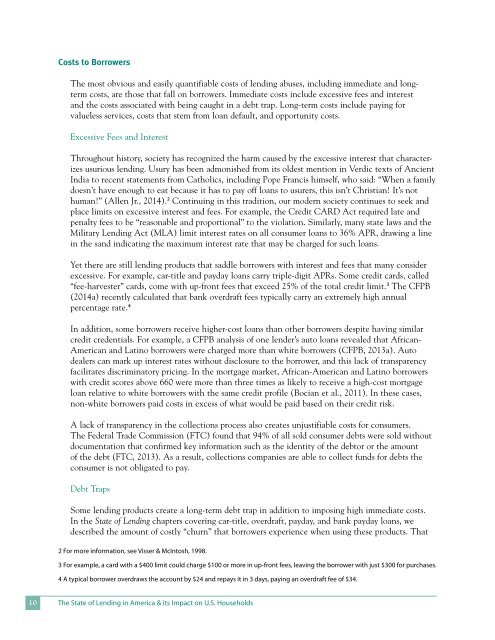You also want an ePaper? Increase the reach of your titles
YUMPU automatically turns print PDFs into web optimized ePapers that Google loves.
<strong>Costs</strong> to Borrowers<br />
<strong>The</strong> most obvious and easily quantifiable costs <strong>of</strong> lending abuses, including immediate and longterm<br />
costs, are those that fall on borrowers. Immediate costs include excessive fees and interest<br />
and the costs associated with being caught in a debt trap. Long-term costs include paying for<br />
valueless services, costs that stem from loan default, and opportunity costs.<br />
Excessive Fees and Interest<br />
Throughout history, society has recognized the harm caused by the excessive interest that characterizes<br />
usurious lending. Usury has been admonished from its oldest mention in Verdic texts <strong>of</strong> Ancient<br />
India to recent statements from Catholics, including Pope Francis himself, who said: “When a family<br />
doesn’t have enough to eat because it has to pay <strong>of</strong>f loans to usurers, this isn’t Christian! It’s not<br />
human!” (Allen Jr., 2014).2 Continuing in this tradition, our modern society continues to seek and<br />
place limits on excessive interest and fees. For example, the Credit CARD Act required late and<br />
penalty fees to be “reasonable and proportional” to the violation. Similarly, many state laws and the<br />
Military Lending Act (MLA) limit interest rates on all consumer loans to 36% APR, drawing a line<br />
in the sand indicating the maximum interest rate that may be charged for such loans.<br />
Yet there are still lending products that saddle borrowers with interest and fees that many consider<br />
excessive. For example, car-title and payday loans carry triple-digit APRs. Some credit cards, called<br />
“fee-harvester” cards, come with up-front fees that exceed 25% <strong>of</strong> the total credit limit.3 <strong>The</strong> CFPB<br />
(2014a) recently calculated that bank overdraft fees typically carry an extremely high annual<br />
percentage rate.4<br />
In addition, some borrowers receive higher-cost loans than other borrowers despite having similar<br />
credit credentials. For example, a CFPB analysis <strong>of</strong> one lender’s auto loans revealed that African-<br />
American and Latino borrowers were charged more than white borrowers (CFPB, 2013a). Auto<br />
dealers can mark up interest rates without disclosure to the borrower, and this lack <strong>of</strong> transparency<br />
facilitates discriminatory pricing. In the mortgage market, African-American and Latino borrowers<br />
with credit scores above 660 were more than three times as likely to receive a high-cost mortgage<br />
loan relative to white borrowers with the same credit pr<strong>of</strong>ile (Bocian et al., 2011). In these cases,<br />
non-white borrowers paid costs in excess <strong>of</strong> what would be paid based on their credit risk.<br />
A lack <strong>of</strong> transparency in the collections process also creates unjustifiable costs for consumers.<br />
<strong>The</strong> Federal Trade Commission (FTC) found that 94% <strong>of</strong> all sold consumer debts were sold without<br />
documentation that confirmed key information such as the identity <strong>of</strong> the debtor or the amount<br />
<strong>of</strong> the debt (FTC, 2013). As a result, collections companies are able to collect funds for debts the<br />
consumer is not obligated to pay.<br />
Debt Traps<br />
Some lending products create a long-term debt trap in addition to imposing high immediate costs.<br />
In the State <strong>of</strong> Lending chapters covering car-title, overdraft, payday, and bank payday loans, we<br />
described the amount <strong>of</strong> costly “churn” that borrowers experience when using these products. That<br />
2 For more information, see Visser & McIntosh, 1998.<br />
3 For example, a card with a $400 limit could charge $100 or more in up-front fees, leaving the borrower with just $300 for purchases.<br />
4 A typical borrower overdraws the account by $24 and repays it in 3 days, paying an overdraft fee <strong>of</strong> $34.<br />
10<br />
<strong>The</strong> State <strong>of</strong> Lending in America & its Impact on U.S. Households


